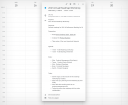Fix your meetings with POPART
Unproductive meetings seem to have become a universal annoyance. At Unc Inc, we have been trying for years to reduce the number of meetings and increase their effectiveness. But the limitations (and annoyances) of online meetings have spurred us to further improve in this regard. Meet POPART, a simple method to "design" meetings that recharge rather than deplete your participants.
Go directly to the tool or first read about the method behind it.
Most office workers spend an idiotic amount of time in meetings. This excess, however, hurts your productivity. Not only because it is time-consuming, but also because working in "blocks" between meetings prevents you from achieving deep concentration for doing complex work. On the other hand, effective meetings are at the very foundation of an organization's success and culture. In optima forma, they efficiently bring together ideas and opinion and help people do their work in a coordinated and collaborative manner. As such, they help build consensus and guide motivation and creative energy.
You'd be surprised how often organizers fail to adhere to the basic requirements of an effective meeting. In fact, a meeting can only be successful if everyone is clear about the purpose, what is expected of them and what the resulting tasks are. The key lies in the right setup, a simple structure that is "sticky" enough to be emulated throughout your organization. To that end, we devised the POPART method, an acronym that stands for Purpose, Objective, Preparation, Agenda, Roles and Tasks.

Purpose - the purpose of the meeting, the topic
How many times have you had a meeting without knowing exactly what it was going to be about? Being unclear about the purpose of a meeting will accomplish little more than a certain waste of your time. So here we formulate the topic of the meeting and make it clear to everyone what the purpose of the meeting is.
For example, we organize an annual workshop with a customer to determine the roadmap, okay, the roadmap for the coming year. In the invitation, we describe a clear purpose of the meeting: Annual Roadmap Workshop for 2021. The topic is Roadmap and we add the period 2021. We indicate that it is a recurring meeting with Annual and finally state the type of meeting: Workshop.
Outcome - the outcomes, the intended result of the meeting
A meeting is a gathering of individuals trying to accomplish something together. So for everything, it should be crystal clear what it is that you are trying to achieve together in this meeting. If this is not the case, there is a good chance that divergent and often implicit ideas about it will cause confusion and delay. In other words, the Outcome is the intended outcome of the meeting.
To continue the above example: the workshop should result in an outline roadmap and a backlog of items for the first quarter. So in addition to the common goal, we also describe desired outcome of the meeting: Determine the roadmap for 2021 & refine the Q1 backlog. In this way, everyone has the same idea about the goals of the meeting.
Preparation - the individual preparation
Without individual preparation, you will have to spend a lot of time informing rather than actually working together. So for participants who are already introduced, this is already immediately wasted time. On top of that, long, informative monologues reduce participants to listeners and generally lower attention and energy. However, if everyone has a good understanding of the challenge beforehand, you can start presenting ideas right away, working out possible solutions, fine-tuning schedules and so on. The key, of course, is good preparation.
Therefore, make sure everyone is clear what preparation you expect of them. Should you assign participants specific roles (see below), make sure they prepare for them if necessary.
As the organizer, you usually have the biggest stake. Therefore, to increase the chances of success, you would do well to remove all possible obstacles to good preparation by participants. Help them, in other words, by making preparation easy. For example, with their limited time, you help them by sending a summary with the main conclusions with a link to the relevant (and available) document instead of asking them to read all 12 pages.
In our example, this could look like this:
- Please read our client's Online Strategy 2020 - 2025.pdf one-pager
- Take a moment to review the updated Product Backlog
- Sum up the most important items to add to next year's roadmap

Agenda - more than a list of topics
The cornerstone of successful meetings since people organized hunting parties for the annual mammoth season. Now that modern times have shortened our attention span considerably, it is wise to limit the number of topics by covering only those that are essential to the Outcome, to the objective of the meeting. Moreover, to "manage" expectations and increase attention, it is good practice to indicate how extensively topics will be discussed. In our experience, time slots per topic work best, the total of which is the intended length of the meeting. Ending earlier earns bonus points because you've just created some rare "free" time for your participants.
Roles - working together on an effective meeting
To keep an eye on the agenda, time and outcomes, every serious meeting needs a chairperson or facilitator. In most cases, this is the organizer or initiator. As I described above, this person is responsible for informing and preparing in advance. As the "leader" of the meeting, it helps if this person has some standing and understanding of the topic. At the very least, she or he should feel confident enough to interrupt if the conversation strays or to continue asking if initial answers are insufficient.
Since the facilitator must keep his or her focus on leading the meeting, minutes or recording individual tasks would ideally be done by another participant. It may be a supporting role but oh so important to get things done. Actually, we think this should be the participants' own responsibility. Therefore, it doesn't hurt to remind them that you expect their full attention and commitment, including recording their own tasks. Ideally, you assign each participant a specific role. But the bare minimum is to let everyone know what each participant's professional role is, especially if there are "externals" present or your meeting is introducing people to each other.
If you have trouble finding a role for each participant, there may be too many people participating. And the more people participate, the less effective it usually becomes. Therefore, make sure you limit the number of participants and don't invite people simply because they are part of a project group or to keep them informed. You don't need a meeting for that.
Tasks - concrete and executable tasks
Last but certainly not least, every meeting should produce tasks that participants have been made responsible for. If nothing concrete has been delegated after the meeting, chances are you will accomplish more or less nothing. Usually you can already list the vast majority of resulting tasks. If you share these even before the meeting starts then this will help participants prepare, think and focus.
In our example, these tasks could look like this:
- Semih shares the results of the roadmap workshop by Tuesday at the latest
- Eltjo makes a planning for the roadmap next Friday
- Nico adds assigns the individual tasks then in our project management tool
- Tessa discusses the roadmap with the other stakeholders
After the meeting, come back to these tasks and make sure they are clear and assigned to specific individuals. Add deadlines and record them in your project management tool to make sure they become part of your schedule.
Our POPART
Putting it all together, this is what the POPART of our meeting would look like:

The POPART meeting design tool
To make it easy for you, we have developed a simple tool to help you use POPART in your meetings. I hope it will help you and your team to increase the outcome and energy of your meetings as much as it did for us. It is only a first version, so suggestions to further improve the tool are very welcome. Thanks in advance and good luck!